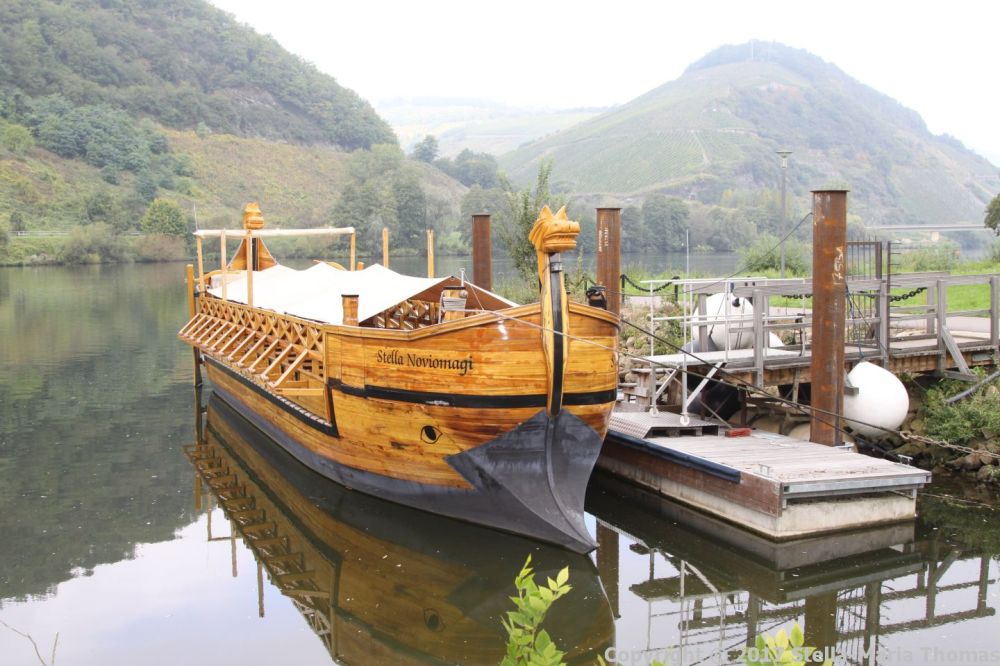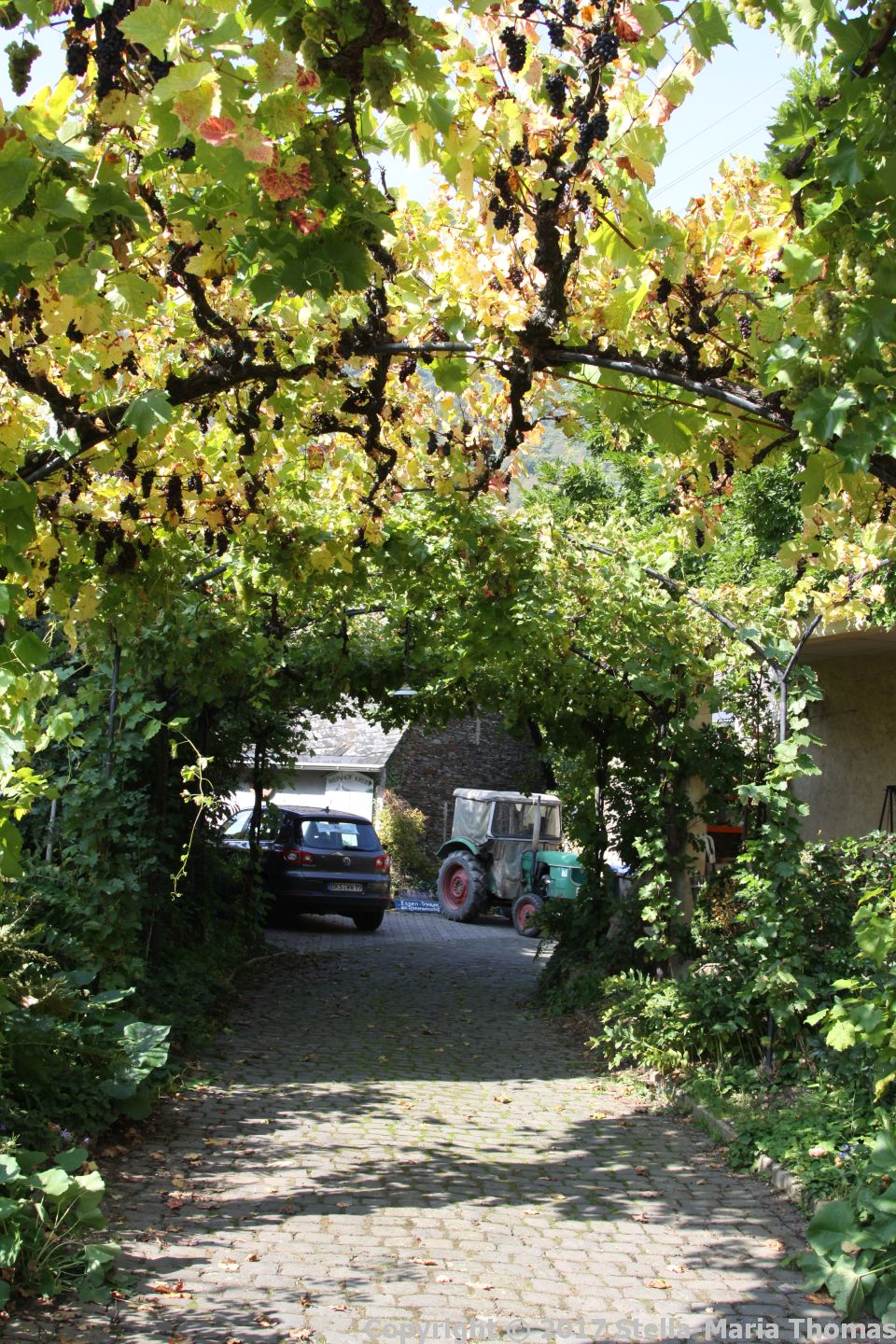Monday September 25th – Day 3, Trier, Neumagen-Dhron, Veldenz, Zeltingen-Rachtig
On Monday we were still with the Romans, starting the day at the Amphitheatre, which was just down the road from our hotel. The day again started with fog on the heights, and it was chilly and damp, which may have been why we pretty much had the place to ourselves.
It was odd, though, because as with so much to see in Trier, compared to Rome, hardly anyone seems to know about it, yet what they have is just as impressive and pretty much as substantial. The place ought to be rammed, though I’m very glad from a personal point of view that it wasn’t. And that’s even given it’s on the edge of the town, but connected via the half hourly hop-on hop-off bus tours. The amphitheatre is just outside the medieval city walls and it’s vast, seating up to 20,000 people it is suggested. Again, a lot of the above ground structural work is gone, used for building materials locally, but the actual arena is still surrounded by a sloping auditorium. We clambered to the top and you can see exactly why the place is still used for open air concerts and festivals; I imagine the acoustics are pretty impressive.
As you can see, the arena itself is surrounded by a wall with openings for animal cages and for entrances and exits. The cellar underneath can be visited too, and there’s a moveable platform that could be used to take people and animals up to the arena. It’s all quite dark and gloomy and if you’re prone to over-imagination I suspect you might find it quite disturbing.
We completed our investigation and got back in the car, headed for another location with plenty of Roman remains, Neumagen-Dhron. It’s another place claiming to be Germany’s oldest wine growing location, probably with some justification in their case. There are bits of Roman masonry everywhere, incorporated into newer buildings, in gardens, in squares. The Tourist Information office offers a useful map showing where each item is. However, first we encountered the most famous of the items that Neumagen-Dhron is known for, a replica of the Roman wine ship. The Stella Noviamagi is moored by the riverside car park and she’s a very fine ship indeed. She was built in 2007 and, apart from being a fascinating piece of experimental archaeology, is also used for trips up and down the river and features in some of the areas wine festivals too.
The circular route takes you round the remains of the late medieval fort that are still extant, with a series of stops on the way, showing replicas of the most important funerary reliefs discovered in Neumagen. The town is sometimes referred to at the “Rheinisches Pergamon” even though a lot of the remains were destroyed or removed between 1878 and 1885 (most of what survived is in the archaeological museum in Trier). This was because the foundations of the tombs had been demolished along with the north side of the castle wall to make a road. The most spectacular part of the wall that still remains is the remarkably solid north tower.
It was excavated and cleared in 1997. The circular tower, 2 metres high, rests on an equally high rectangular foundation, the lowest layer of which is formed by a layer of reused blocks with half-roll-shaped covers. Since the four mighty unedited blocks were not “spectacular tomb remains”, they were left in place and thus the tower is now clearly visible again.
A replica of the funerary ornament that served as the model for the wine ship is on show in the town square and is probably one of the most complete items on the walk.
Neumagen is small but rather lovely, and also does a fine line in Art Deco buildings, reflecting a phase when wines from the region were highly prized and the economy, after centuries of poverty, was booming once again. There is a lot of this to be seen along the Moselle.
Everything was beautifully autumnal with the grape harvest in full swing everywhere, earlier than normal by around three weeks we were told. There were tractors everywhere!
Eventually, having run out of Roman remains, we retreated back to the cafe, the Kapt’n Cook, for a light lunch that turned out to be anything but. It being autumn, there is game everywhere, and wild mushrooms, especially chanterelles (pfifferlingen). A small carafe of wine while we had a think about what to order was very pleasant, especially as the weather was now gorgeously sunny.
Lynne went for a schnitzel with chanterelles (it was huge):
It also came with a vast side salad:
I went for the pasta with onions, bacon and chanterelles:
We had planned that I would cook that evening, but after we’d battled our way through the massive portions it looked like I might not need to bother! We set off from Neumagen intending to head straight for our final destination for the day but then we got a bit sidetracked by signs for more Roman vestiges, this time at Veldenz, a tiny village up from the river and the vineyards and into the more wooded country that runs alongside the river.
In the centre there is a community centre that contains a small museum, and in addition the remains of a Roman bath house that was discovered when the municipality took over the building and had to do some serious renovation work. The charming lady working there unlocked everything for us and let us potter around looking at the preserved remains.
I think the oddest part about it is that no one knew it was there. It’s a large complicated building and it is highly likely that a lot of the other buildings in the town may be on top of more of the bath house. The small museum contained a variety of things including a display of bank notes, a lot of archaeology finds, and a collection of Maerklin constructions.
It was all rather fun. From there we headed up the valley a little further to see what we could see of Schloss Veldenz, the ruins of a castle built in 1107. Turned out the answer was “not very much”. There were lots of signs at the bottom of the hill it sits on saying words to the effect of “Private – Keep Out!” so we settled for trying to find a place from which to photograph it to best effect.
It was late afternoon now so we gave up and headed for Zeltingen-Rachtig where we would be staying for six nights, renting a small house through AirBnB. I wasn’t feeling too great with a sore throat and a case of the snuffles so it was time for some drugs for that, and a supermarket run for supplies. As Lynne was also feeling a bit off after the massive lunch in Neumagen-Dhron, we settled for a light supper and an early night.





























































































































































I think that’s the most impressive adventure of your trip so far.
LikeLike
We seem to have had a lot of castles and a lot of Roman villas, along with a lot of vineyards.
LikeLike
Our experience of castle hunting has been that frequently many are not maintained or non accessible – in the sense one cannot get in to take pictures of it. So many were taken from a distance. Did you encounter this? Perhaps that has all changed after these many years since we last went
LikeLike
in some instances yes, we did find that. Day four was a case in point but mostly it was a case of having to avoid Mondays when a lot of places are closed, and quite often you could only visit as part of a group guided tour.
LikeLiked by 1 person
Oh yes that’s right. Only group tours we remember that!
LikeLike